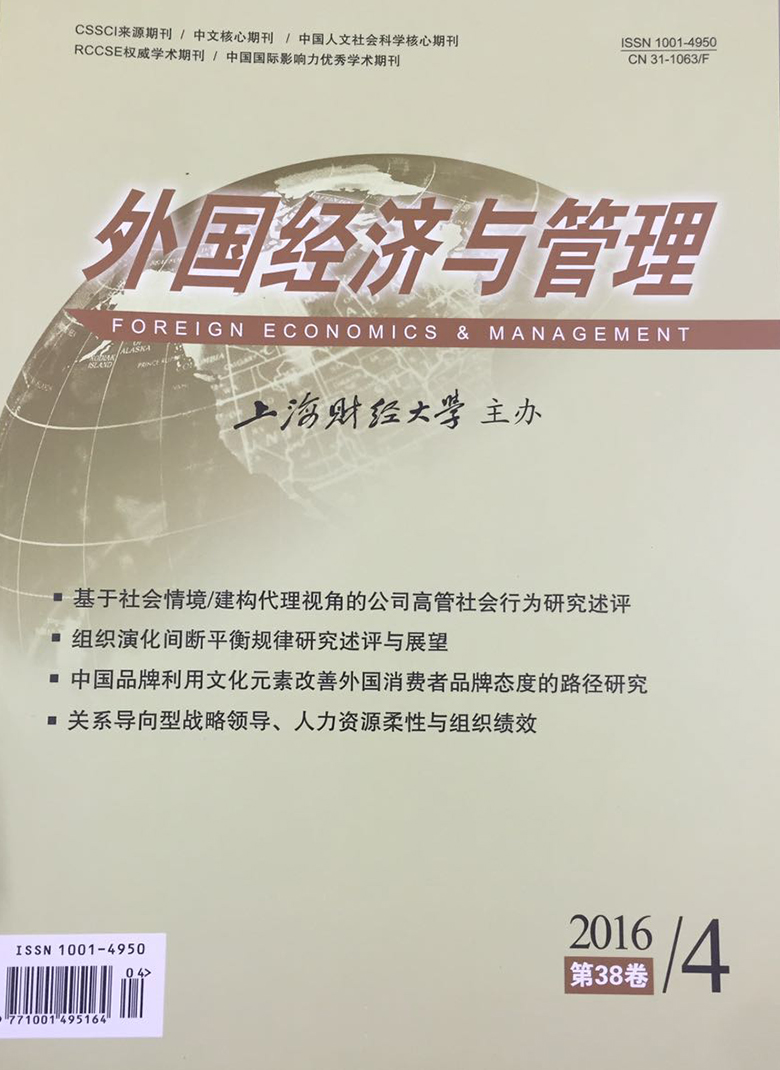本文基于锦标赛理论和公平理论,以总经理与副总经理之间的垂直薪酬差异作为不同级别高管之间的薪酬差异,以副总经理之间的平行薪酬差异作为同级别高管之间的薪酬差异,采用2005-2013年我国A股上市公司数据,考察了垂直薪酬差异和平行薪酬差异对副总经理的筛选效应。同时,由于不同产权性质企业的高管职位晋升机制和薪酬制度存在差异,这可能会影响薪酬差异对副总经理的筛选效应,因而本文还考察了不同产权性质企业的垂直薪酬差异和平行薪酬差异对副总经理的筛选效应的差异。研究发现,垂直薪酬差异和平行薪酬差异越高,则副总经理主动离职率越高,说明垂直薪酬差异和平行薪酬差异均会对副总经理产生负向的筛选效应;与非国有企业相比,垂直薪酬差异和平行薪酬差异对国有企业副总经理主动离职率的正向影响更大,说明垂直薪酬差异和平行薪酬差异对国有企业副总经理的负向筛选效应要强于非国有企业。进一步研究还发现,垂直薪酬差异和平行薪酬差异均会通过副总经理主动离职率显著地间接负向影响公司绩效,说明垂直薪酬差异和平行薪酬差异对副总经理的筛选效应均会负向影响公司绩效。本文不仅拓展了薪酬差异对高管筛选效应的研究,还为薪酬差异通过高管主动离职行为对公司绩效的影响机制提供了经验证据。
薪酬差异、高管主动离职率与公司绩效
摘要
参考文献
1 陈 冬华, 陈 信元, 万 华林. 国有企业中的薪酬管制与在职消费. 经济研究, 2005 (2): 92–101
2 陈 信元, 陈 冬华, 万 华林, et al. 地区差异、薪酬管制与高管腐败. 管理世界, 2009 (11): 130–143
3 黎 文靖, 胡 玉明. 国企内部薪酬差距激励了谁?. 经济研究, 2012 (12): 125–136
4 梁 建, 陈 爽英, 盖 庆恩. 民营企业的政治参与、治理结构与慈善捐赠. 管理世界, 2010 (7): 109–118
5 刘 小玄. 企业边界的重新确定: 分立式的产权重组——大中型国有企业的一种改制模式. 经济研究, 2001 (4): 3–13
6 缪 毅, 胡 奕明. 产权性质、薪酬差距与晋升激励. 南开管理评论, 2014 (4): 4–12
7 王 锟, 李 伟. 高管政治背景对其离职—业绩敏感性的影响. 南开管理评论, 2012 (6): 104–110
8 温 忠麟, 叶 宝娟. 中介效应分析: 方法和模型发展. 心理科学进展, 2014 (5): 731–745
9 吴 延兵. 国有企业双重效率损失研究. 经济研究, 2012 (3): 15–27
10 辛 清泉, 谭 伟强. 市场化改革、企业业绩与国有企业经理薪酬. 经济研究, 2009 (11): 68–81
11 周 权雄, 朱 卫平. 国企锦标赛激励效应与制约因素研究. 经济学(季刊), 2010 (2): 571–596
12 Allison P D. Measures of inequality. American Sociological Review, 1978, 43(6): 865–880
13 Bebchuk L A, Martijn Cremers K J, Peyer U C. The CEO pay slice. Journal of Financial Economics, 2001, 102(1): 199–221
14 Bloom M. The performance effects of pay dispersion on individuals and organizations. Academy of Management Journal, 1999, 42(1): 25–40
15 Bloom M, Michel J G. The relationships among organizational context,pay dispersion,and managerial turnover. Academy of Management Journal, 2002, 45(1): 33–42
16 Carnahan S, Agarwal R, Campbell B A. Heterogeneity in turnover: The effect of relative compensation dispersion of firms on the mobility and entrepreneurship of extreme performers. Strategic Management Journal, 2012, 33(12): 1411–1430
17 Cowherd D M, Levine D I. Product quality and pay equity between lower-level employees and top management: An investigation of distributive justice theory. Administrative Science Quarterly, 1992, 37(2): 302–320
18 Ding D Z, Akhtar S, Ge G L. Effects of inter-and intra-hierarchy wage dispersions on firm performance in Chinese enterprises. The International Journal of Human Resource Management, 2009, 20(11): 2370–2381
19 Downes P E, Choi D. Employee reactions to pay dispersion: A typology of existing research. Human Resource Management Review, 2014, 24(1): 53–66
20 Earley P C. Social loafing and collectivism: A comparison of the United States and the People's Republic of China. Administrative Science Quarterly, 1989, 34(4): 565–581
21 Eriksson T. Executive compensation and tournament theory: Empirical tests on Danish data. Journal of Labor Economics, 1999, 17(2): 262–280
22 Faleye O, Reis E, Venkateswaran A. The determinants and effects of CEO-employee pay ratios. Journal of Banking & Finance, 2013, 37(8): 3258–3272
23 Festinger L. A theory of social comparison processes. Human Relations, 1954, 7(2): 117–140
24 Fredrickson J W, Davis-Blake A, Sanders W M G. Sharing the wealth:Social comparisons and pay dispersion in the CEO's top team. Strategic Management Journal, 2010, 31(10): 1031–1053
25 Hambrick D C. Fragmentation and the other problems CEOs have with their top management teams. California Management Review, 1995, 37(3): 110–127
26 Henderson A D, Fredrickson J W. Top management team coordination needs and the CEO pay gap: A competitive test of economic and behavioral Views. Academy of Management Journal, 2001, 44(1): 96–117
27 Kale J R, Reis E, Venkateswaran A. Rank-order tournaments and incentive alignment: The effect on firm performance. The Journal of Finance, 2009, 64(3): 1479–1512
28 Kale J R, Reis E, Venkateswaran A. Pay inequalities and managerial turnover. Journal of Empirical Finance, 2014, 27: 21–39
29 Kini O, Williams R. Tournament incentives,firm risk,and corporate policies. Journal of Financial Economics, 2012, 103(2): 350–376
30 Lazear P E, Rosen S. Rank-order tournaments as optimum labor contracts. Journal of Political Economy, 1981, 89(5): 841–864
31 Lee K W, Lev B, Yeo G H H. Executive pay dispersion,corporate governance and firm performance. Review of Quantitative Finance and Accounting, 2008, 30(3): 315–338
32 March J C, March J G. Almost random careers: The wisconsin school superintendency,1940-1972. Administrative Science Quarterly, 1977, 22(3): 377–409
33 Messersmith J G, Guthrie J P, Ji Y Y, et al. Executive turnover: The influence of dispersion and other pay system characteristics. The Journal of Applied Psychology, 2011, 96(3): 457–469
34 Papke L E, Wooldridge J M. Econometric methods for fractional response variables with an application to 401(k) plan participation rates. Journal of Applied Econometrics, 1996, 11(6): 619–632
35 Ridge J W, Hill A D, Aime F. Implications of multiple concurrent pay comparisons for top-team turnover. Journal of Management, 2014
36 Rosen S. Prizes and incentives in elimination tournaments. American Economic Review, 1986, 76(4): 701–715
37 Trevor C O, Reilly G, Gerhart B. Reconsidering pay dispersion's effect on the performance of interdependent work: Reconciling sorting and pay inequality. Academy of Management Journal, 2012, 55(3): 585–610
38 Wade J B, O'Reilly Ⅲ C A, Pollock T G. Overpaid CEOs and underpaid managers: Fairness and executive compensation. Organization Science, 2006, 17(5): 527–544
引用本文
梅春, 赵晓菊. 薪酬差异、高管主动离职率与公司绩效[J]. 外国经济与管理, 2016, 38(4): 19–35.
导出参考文献,格式为:





 7991
7991  7397
7397

